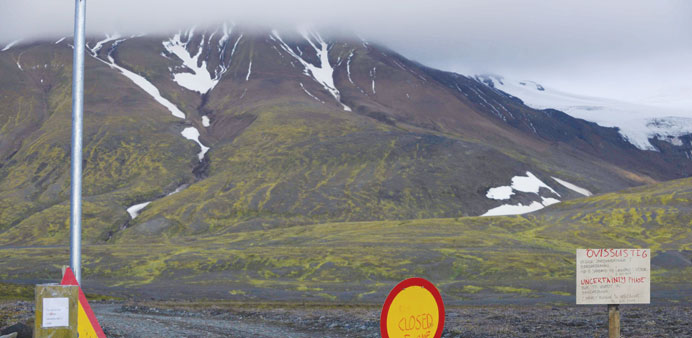AFP/Reykjavík
Icelandic aviation authorities yesterday warned an eruption of the nation’s largest volcano would trigger a shutdown of airspace, in a potential replay of the global travel chaos triggered when another peak blew four years ago.
Authorities evacuated tourists and hikers overnight from the area around Bardarbunga volcano, which kicked into seismic action on Monday with the biggest earthquake registered since 1996.
“There’s nothing we can do if we get another big eruption like that of Eyjafjoell except to interrupt air traffic in the dangerous areas,” Icelandic Civil Aviation Administration spokesman Fridthor Eydal was quoted as saying on news site mbl.is. “It’s really the only thing we can do.”
The eruption of Eyjafjoell, a smaller volcano, in April 2010 caused travel mayhem, stranding more than 8mn travellers in the biggest airspace shut down since World War II.
Experts said Bardarbunga was stable yesterday, but still in danger of erupting. Up to 300 people were believed to be have been evacuated in the area around the volcano, located in southeast Iceland under the country’s largest glacier Vatnajoekull. Air patrols continued in the area to ensure no-one remained.
“We of course don’t know about all hikers and such, but we are going to look over the area with the aid of the Coast Guard and after that we should be very certain that no-one is in the area,” Vidir Reynisson at the Civil Protection Authority (CPA) told public broadcaster RUV. The area around the volcano is uninhabited, with only trekking cabins and campsites used by tourists and hunters in the summer months.
Iceland’s second-highest peak, Bardarbunga rises to more than 2,000m, and caps the country’s largest volcanic system. On Monday, seismologists recorded an earthquake of 4.5 on the Richter scale in the area.
Scientists believe its explosion would be large enough to disrupt air traffic over northern Europe and the northern Atlantic, as well as causing major damage on the island nation from volcanic ash and glacial flooding.
But with its activity largely stable for four days straight, authorities said it was unlikely any explosion is imminent.
“There is no change in the seismic activity at the moment and no sign of an eruption,” the CPA said in a statement, adding that “experience shows that seismic activity can be going on for a long time without an eruption going off”.
In 2010, the Eyjafjoell volcano shot a massive plume of volcanic debris up to 9km into the sky, blowing ash across to mainland Europe.
And in 2011, Iceland’s most active sub-glacial volcano Grimsvotn erupted, forcing Iceland to temporarily shut its airspace and sparking fears of a repeat of the Eyjafjoell flight chaos.

Warning signs block the road to Bardarbunga volcano in the north-west region of the Vatnajokull glacier.


